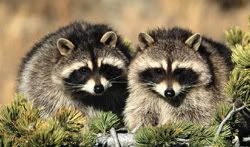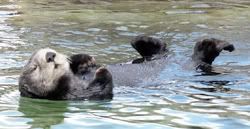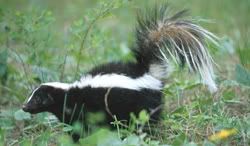
Florida Black Bear, (Ursus americanus floridanus), is found in localized large heavily-wooded areas state-wide. It is large (50-80″) and bulky (180-300 pounds). Its black coat is thick and long. It has a tan muzzle and a short tail. It has short, curved claws.
The Florida black bear dens, usually alone, in cavities in trees, banks, logs, and in caves. It also nests on the ground, particularly in palmetto thickets and tangles of gallberry, fetterbush and sweet pepperbush. It is active primarily at night. An omnivore, it feeds on fruits, nuts, roots, twigs, bark, small animals, eggs, honey, and carrion.
In northern Florida, the bear goes into a dormant period during colder months but does not hibernate. While its body temperature, metabolism, and heart rate decrease, it is easily disturbed.
Females breed every other year in June or July and give birth to 1-4 cubs in January or February. The cubs remain with the mother until the spring of the following year.
Bears will avoid humans, but can be very dangerous, especially when protecting cubs.
Florida Panther, (Felis concolor coryi), is found primarily in southern Florida in the Everglades and Big Cypress Swamp. It is a large, slender cat with a tawny coat and white belly. Black marks the sides of the muzzle and top of the tail. It has a broad head with small, rounded ears. Length varies from 74-86″, and weight ranges from 70-160 pounds. Males are larger than females. Cats have 5 toes on the front feet and 4 toes on the hind feet. While there are many common names for Florida cats, there are actually only two species.

The Florida panther remains solitary except when mating. The female raises her young. Known litters have included 1-4 kittens. They remain with the mother for 12-18 months, leaving the nest to accompany her while hunting when they’re about 2 months old.
The panther prefers true wilderness habitats, actively avoiding humans. It is usually inactive during the day except in winter. It needs a large area for hunting, as it usually moves 15-20 miles per day. It feeds primarily on wild hogs and white-tailed deer, but will eat smaller mammals. It will occasionally kill livestock; however, there has never been a panther attack on a human.
In 1958, the Florida panther was declared an endangered species. Today there are only 30-50 left. Humans and dogs are their only predators. From 1978 to 1988, there were 20 known panther deaths. Of these, 11 were the result of vehicle collisions and 5 were shootings. The panther, by a vote of school children, became the state mammal in 1982.
It is also called the puma, cougar, catamount and mountain lion.
Bobcat, (Lynx rufus), is found in non-aquatic habitats throughout the state. It is tawny to olive brown with black spots and streaks and a white black-spotted belly. Its tail is short, 4-6″, with a white tip. It has a broad head and tufted, pointed ears. The claws are razor-sharp. It reaches a length of 30-43″.

It is a solitary, mostly nocturnal animal. Home ranges cover 10-25 square miles. Males are territorial, females are not. Bobcats often rest in trees and palmetto thickets. Diet consists primarily of rodents and rabbits, but may include other small mammals, game birds and songbirds, snakes, lizards, and domestic cats.
Most breeding occurs during the winter. Litters of 1-6 kittens are born about 62 days later. Kittens remain with the mother through the first winter. Bobcats, even kittens, are extremely dangerous when cornered. Predators are dogs and man. Great horned owls, panthers, coyotes, and foxes may prey on kittens.
Bobcats can transmit rabies and feline distemper.
Coyote, (Canis latrans), naturally expanded its range into Florida in the 1970’s. It is now found throughout the state, primarily in fields, pastures, and other open areas. It is light to reddish gray with rust coloured ears and legs, a black-tipped tail, and a lighter coloured underside. It is 41-52″ long overall.

It digs large dens, tunnelling 10-20 feet and creating a nest chamber at the end. There are at least two entrances, each about 10″ wide and 20″ high.
Rabbits and rodents make up most of its diet but it is an opportunistic feeder. It also eats reptiles, amphibians, birds, fruit … such as grapes, blackberries and pawpaws, seeds, and carrion.
Breeding occurs in late winter or early spring with a litter of 2-12 pups born about 60 days later. Both parents tend the young (and may remain together for life). The pups stay with the parents for about six months.
Predators are man and dogs.
Gray Fox, (Urocyon cinereoargenteus), are found in densely wooded areas through the state except for the Keys. It is silver gray with reddish sides and a white underside. It has a pointed muzzle and a long (10-16″), bushy tail with a black stripe and tip. It is 31-44″ long.

It is primarily nocturnal, sending the daylight hours in an underground den or hollow log. The gray fox is agile and fast. It can run 30mph for short distances. It climbs trees to escape predators, to rest, and to pursue prey.
Cottontail and marsh rabbits make up most of its diet which also includes rice and cotton rats, deer mice, insects, songbirds, acorns, and fruits such as pawpaws and grapes.
Breeding occurs during the winter producing a litter of 1-7 pups about 53 days later. When the pups are 5-6 weeks old, the male assists with food gathering. They will stay together until late summer.
Predators are man and dogs.
Red Fox, (Vulpes vulpes), is found in neglected citrus groves and pine and oak woods state-wide except for the Keys. It is sandy red with a white underside. The end of the long (11-16″) tail is black with a white tip. Its cheeks and throat are white and its legs and feet are black. Its muzzle and ears are pointed. It is 33-43″ long.
It is primarily nocturnal. Its den is usually 20-40 feet long and has more than one entrance.

The red fox’s diet is composed mainly of rabbits, rats, and mice. It also eats birds, amphibians, reptiles, and fruit. It caches food on occasion.
Red foxes are monogamous, apparently for life. They breed in late winter or early spring, producing a litter of 1-10 pups about 53 days later. At about 6 months of age, the pups move off on their own.
Predators include man, dogs, and bobcats.
Raccoon, (Procyon lotor), is found in areas with trees, including urban areas, state-wide. It is gray, brown, and black with a pale brown underside. Its face is lighter with a black mask. Its hind legs are longer than its forelegs. It is 30-35″ long with a 9-12″ banded tail and weighs 10-15 pounds.

It is omnivorous and opportunistic. Its diet includes fruits, nuts, seeds, vegetables, roots, amphibians, reptiles, fish, birds, and insects. It also forages in garbage and has displayed an uncanny ability to open coolers and other camping equipment.
The raccoon typically sleeps in trees during the day, becoming active in the late afternoon. It has several den sites within its home range (1 mile in diameter for males, .75 for females).
Breeding usually occurs during December or January. The male wanders off in search of another mate. A litter of 3-4 kits is born about 60 days later. The female is very protective of her offspring.
Predators include man, dogs, bobcats, panthers, and great horned owls.
Raccoons are primary carriers of rabies in Florida and may also carry distemper and tuberculosis. There is only one raccoon species in Florida.
Mink, (Mustela vison), is found in coastal habitats along the Gulf Coast south to Hernando County and along the Atlantic Coast south to Matanzas Inlet. It is glossy, blackish brown with a long (20-24″), slender body, short legs and a long (7-8″) bushy tail. It has small rounded ears and a white chin.

It is active primarily at night, foraging for food in the water and along the banks. Diet consists of mammals, frogs, insects, birds, reptiles, and fish.
Breeding season is from late winter to spring. Litters of 3-4 kits are born about 50 days later.
Everglades Mink, (Mustela vison evergladensis), is found in shallow freshwater marshes of the Everglades and Big Cypress Swamp.
Its diet is primarily crayfish, fish, and small mammals.
There is evidence that the breeding season is from September to November.
River Otter, (Lutra canadensis), is found in most freshwater habitats in the panhandle and peninsula. It is glossy brown with a paler or gray tan underside. It has an elongated 35-43″ body with a long (12-16″) muscular tail. It has a small, flattened head, small, rounded ears, short legs, and webbed toes.

It swims at about 6mph and can remain underwater 3-4 minutes. It tends to be nocturnal and lives in bank burrows under tree roots or in dense vegetation.
Diet is mainly fish and crayfish but may include turtles, frogs, snakes, salamanders, clams, birds, rodents, and fruit. It caches food.
The river otter breeds in late summer or fall. The litter of 1-6 kits is born about 11 months later. They will stay with the mother about a year. Predators are alligators and humans.
Striped Skunk, (Mephitis mephitis), also known as the “polecat”, is found state-wide except in the Keys. It is black with two white stripes down the back though the stripes vary from not being present to the entire back being white. It has a small head, short legs, and a plumed 8-14″ tail. Its body length is 23-28″.

The striped skunk has scent glands that can spray up to 15 feet. The smell can be detected as far as 1.5 miles away. It is a slow-moving animal that seldom climbs. It can swim short distances. Usually solitary, it digs its own den or uses the den of an armadillo, fox, or gopher tortoise. During cold weather, it sleeps for extended periods of time.
An omnivore, it eats mostly insects, but also reptiles, amphibians, rodents, crayfish, birds, eggs, roots, nuts, seeds, fruit such as grapes, grass, and mushrooms.
Breeding occurs once a year in the spring, with a litter of 2-10 kits born about 65 days later. The kits stay with the mother until late summer. Its primary predator is the great horned owl which is oblivious to the skunk’s spray.
It can carry rabies and leptospirosis.
Eastern Spotted Skunk, (Spilogale putoriur), is found in dry prairies, fields, and brush statewide except for the Keys. It is also commonly called “civet cat” and “weasel skunk”. It is black with white spots and wide, wavy stripes, and a bushy 6-8″ tail. It has small eyes and ears and short legs. There is a white spot on the forehead and in front of each ear. It is 16-21″ long.
It has musk glands which can spray 12-15 feet. It does a series of handstands before spraying. The Eastern spotted skunk is nocturnal, spending the daytime sleeping in an underground den. Dens are often dug under buildings, logs, woodpiles, and brush piles. It is an excellent climber.
An omnivore, it primarily eats insects but also reptiles, amphibians, rodents, birds, eggs, fish, roots, and nuts.
It breeds in late winter and may breed again in late summer. A litter of 2-9 kits are born after a gestation of about 60 days.
Primary predators are great horned owls and barred owls. Other predators include bobcats, foxes, coyotes, and dogs.
It may carry rabies and leptospirosis.
Long-tailed Weasel, (Mustela frenata), is found in non aquatic habitats state-wide. It is rich dark brown with a white underside, a long (14-18″) body, long neck, and a long (6-7″), black-tipped tail. It has a pointed nose and small eyes.

Diet consists primarily of rodents, reptiles, rabbits, frogs, and birds. They are especially fond of poultry.
While normally quite shy, a cornered weasel can become very aggressive.
Southeastern Weasel, Mustela frenata olivacea, is found in northern Florida and the panhandle. It is chestnut brown with a yellowish white underside. The end of the tail is black.
It dens in hollow trees and burrows, including gopher tortoise and pocket gopher burrows.
Its diet is primarily rodents but includes other small animals.
One litter is born in late fall or early winter.
Florida Weasel, Mustela frenata peninsulae, is found in a variety of habitats in central Florida. It is similar in all respects to the South-eastern weasel, except slightly larger with coarser fur.

No comments yet.